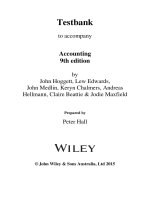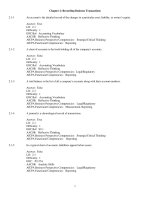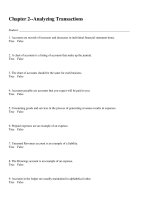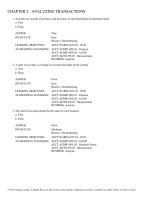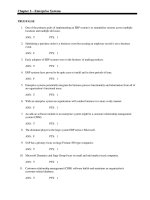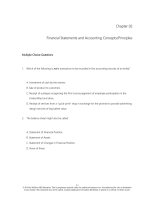Horngrens accounting 10th edition nobles test bank
Bạn đang xem bản rút gọn của tài liệu. Xem và tải ngay bản đầy đủ của tài liệu tại đây (735.66 KB, 48 trang )
Horngren's Accounting, 10e (Nobles/Mattison/Matsumura)
Chapter 2 Recording Business Transactions
Learning Objective 2-1
1) A chart of accounts is a detailed record of the changes in a particular asset, liability, or owner's equity.
Answer: FALSE
Diff: 1
LO: 2-1
AACSB: Concept
AICPA Functional: Measurement
2) A chart of accounts is a list of all of a company's accounts with their account numbers.
Answer: TRUE
Diff: 1
LO: 2-1
AACSB: Concept
AICPA Functional: Measurement
3) Liabilities are economic resources that are expected to benefit the business in the future.
Answer: FALSE
Diff: 1
LO: 2-1
AACSB: Concept
AICPA Functional: Measurement
4) A payment of an expense in advance is called a prepaid expense.
Answer: TRUE
Diff: 1
LO: 2-1
AACSB: Concept
AICPA Functional: Measurement
5) An accounts receivable requires the business to pay cash in future.
Answer: FALSE
Diff: 1
LO: 2-1
AACSB: Concept
AICPA Functional: Measurement
6) A payable involves a future receipt of cash.
Answer: FALSE
Diff: 1
LO: 2-1
AACSB: Concept
AICPA Functional: Measurement
1
Copyright © 2014 Pearson Education, Inc.
7) Unearned revenue is a liability account.
Answer: TRUE
Diff: 1
LO: 2-1
AACSB: Application
AICPA Functional: Measurement
8) The account title used for recording the prepayment of rent for a building in the future is:
A) prepaid rent.
B) rent payable.
C) rent revenue.
D) rent expense.
Answer: A
Diff: 1
LO: 2-1
AACSB: Application
AICPA Functional: Measurement
9) ________ represents a debt owed for renting a building currently.
A) Prepaid rent
B) Rent payable
C) Rent revenue
D) Rent expense
Answer: B
Diff: 1
LO: 2-1
AACSB: Application
AICPA Functional: Measurement
10) Nuptial Inc. paid the rent for the current month in cash. Which of the following account titles will be
debited?
A) Prepaid rent
B) Rent payable
C) Rent revenue
D) Rent expense
Answer: D
Diff: 1
LO: 2-1
AACSB: Application
AICPA Functional: Measurement
2
Copyright © 2014 Pearson Education, Inc.
11) Which of the following is a liability account?
A) Accounts Receivable
B) Cash
C) Building
D) Notes Payable
Answer: D
Diff: 1
LO: 2-1
AACSB: Concept
AICPA Functional: Measurement
12) Which of the following is an asset account?
A) Wages Payable
B) Notes Payable
C) Unearned Revenue
D) Accounts Receivable
Answer: D
Diff: 1
LO: 2-1
AACSB: Concept
AICPA Functional: Measurement
13) A customer's promise to pay in the future for services or goods sold is called a(n):
A) Accounts Receivable.
B) Accounts Payable.
C) Unearned Revenue.
D) Notes Payable.
Answer: A
Diff: 1
LO: 2-1
AACSB: Concept
AICPA Functional: Measurement
14) Which of the following is a collection of all the accounts, the changes in those accounts, and their
balances?
A) source document
B) journal
C) ledger
D) trial balance
Answer: C
Diff: 1
LO: 2-1
AACSB: Concept
AICPA Functional: Measurement
3
Copyright © 2014 Pearson Education, Inc.
15) Which of the following is an asset account?
A) Salaries Expense
B) Accounts Payable
C) Service Revenue
D) Prepaid Expense
Answer: D
Diff: 1
LO: 2-1
AACSB: Concept
AICPA Functional: Measurement
16) Which of the following is a liability account?
A) Accounts Payable
B) Prepaid Expense
C) Salaries Expense
D) Service Revenue
Answer: A
Diff: 1
LO: 2-1
AACSB: Concept
AICPA Functional: Measurement
17) The earnings that result from delivering goods or services to customers are called:
A) notes receivable.
B) unearned revenues.
C) capital.
D) revenues.
Answer: D
Diff: 1
LO: 2-1
AACSB: Concept
AICPA Functional: Measurement
18) Which of the following details is provided in a typical chart of accounts?
A) account balance
B) account number
C) dates of transactions
D) transaction amounts
Answer: B
Diff: 1
LO: 2-1
AACSB: Concept
AICPA Functional: Measurement
4
Copyright © 2014 Pearson Education, Inc.
19) A liability created when a business collects cash from customers in advance of providing services or
delivering goods is called:
A) notes receivable.
B) unearned revenues.
C) capital.
D) revenues.
Answer: B
Diff: 1
LO: 2-1
AACSB: Concept
AICPA Functional: Measurement
20) Which of the following is a liability account?
A) Service Revenue
B) Building
C) Accounts Receivable
D) Unearned Revenue
Answer: D
Diff: 1
LO: 2-1
AACSB: Concept
AICPA Functional: Measurement
21) A listing of all account titles in numerical order is called a(n):
A) ledger.
B) journal.
C) income statement.
D) chart of accounts.
Answer: D
Diff: 1
LO: 2-1
AACSB: Concept
AICPA Functional: Measurement
22) Which of the following is an asset account?
A) Cash
B) Notes Payable
C) Owner's Withdrawals
D) Expenses
Answer: A
Diff: 2
LO: 2-1
AACSB: Concept
AICPA Functional: Measurement
5
Copyright © 2014 Pearson Education, Inc.
23) Which type of account is Owner's Capital?
A) equity
B) asset
C) liability
D) revenue
Answer: A
Diff: 2
LO: 2-1
AACSB: Concept
AICPA Functional: Measurement
24) An amount owed but not paid is called a(n):
A) prepaid expense.
B) adjusted liability.
C) accrued liability.
D) note receivable.
Answer: C
Diff: 1
LO: 2-1
AACSB: Concept
AICPA Functional: Measurement
Learning Objective 2-2
1) Debit refers to the right side of the T-account and credit refers to the left side.
Answer: FALSE
Diff: 1
LO: 2-2
AACSB: Concept
AICPA Functional: Measurement
2) The system of accounting in which every transaction affects at least two accounts is called the doubleentry system.
Answer: TRUE
Diff: 1
LO: 2-2
AACSB: Concept
AICPA Functional: Measurement
3) An asset account is increased by a debit.
Answer: TRUE
Diff: 1
LO: 2-2
AACSB: Concept
AICPA Functional: Measurement
6
Copyright © 2014 Pearson Education, Inc.
4) The Owner's Capital account is increased by a debit.
Answer: FALSE
Diff: 1
LO: 2-2
AACSB: Concept
AICPA Functional: Measurement
5) The Owner's Withdrawals account is increased by a debit.
Answer: TRUE
Diff: 1
LO: 2-2
AACSB: Concept
AICPA Functional: Measurement
6) A liability account is increased by a debit.
Answer: FALSE
Diff: 1
LO: 2-2
AACSB: Concept
AICPA Functional: Measurement
7) An account that normally has a debit balance may occasionally have a credit balance.
Answer: TRUE
Diff: 1
LO: 2-2
AACSB: Concept
AICPA Functional: Measurement
8) All asset accounts and equity accounts increase with a debit.
Answer: FALSE
Diff: 1
LO: 2-2
AACSB: Concept
AICPA Functional: Measurement
9) The balances in the accounts of liabilities and revenues are increased with a credit.
Answer: TRUE
Diff: 1
LO: 2-2
AACSB: Concept
AICPA Functional: Measurement
10) The normal balance of an account is the increase side of the account.
Answer: TRUE
Diff: 1
LO: 2-2
AACSB: Concept
AICPA Functional: Measurement
7
Copyright © 2014 Pearson Education, Inc.
11) When a business makes a cash payment, the Cash account is debited.
Answer: FALSE
Diff: 2
LO: 2-2
AACSB: Concept
AICPA Functional: Measurement
12) When a business collects cash, the Cash account is debited.
Answer: TRUE
Diff: 2
LO: 2-2
AACSB: Concept
AICPA Functional: Measurement
13) When a business records an expense incurred, the Expense account is credited.
Answer: FALSE
Diff: 2
LO: 2-2
AACSB: Concept
AICPA Functional: Measurement
14) When a business records revenue earned, the Revenue account is credited.
Answer: TRUE
Diff: 2
LO: 2-2
AACSB: Concept
AICPA Functional: Measurement
15) A debit always means a decrease and a credit means increase.
Answer: FALSE
Diff: 1
LO: 2-2
AACSB: Concept
AICPA Functional: Measurement
16) Which of the following accounts increases with a credit?
A) Cash
B) Smith, Capital
C) Accounts Receivable
D) Prepaid Expenses
Answer: B
Diff: 1
LO: 2-2
AACSB: Concept
AICPA Functional: Measurement
8
Copyright © 2014 Pearson Education, Inc.
17) Which of the following accounts decreases with a credit?
A) Cash
B) Smith, Capital
C) Accounts Payable
D) Notes Payable
Answer: A
Diff: 1
LO: 2-2
AACSB: Concept
AICPA Functional: Measurement
18) Which of the following accounts increases with a debit?
A) Cash
B) Interest Payable
C) Accounts Payable
D) Smith, Capital
Answer: A
Diff: 1
LO: 2-2
AACSB: Concept
AICPA Functional: Measurement
19) Which of the following accounts decreases with a debit?
A) Accounts Receivable
B) Notes Payable
C) Cash
D) Land
Answer: B
Diff: 1
LO: 2-2
AACSB: Concept
AICPA Functional: Measurement
20) Which of the following groups of accounts normally have a credit balance?
A) assets and liabilities
B) capital and assets
C) liabilities and owner's equity
D) assets and expenses
Answer: C
Diff: 1
LO: 2-2
AACSB: Concept
AICPA Functional: Measurement
9
Copyright © 2014 Pearson Education, Inc.
21) Which of the following groups of accounts normally have a debit balance?
A) assets and expenses
B) revenues and expenses
C) liabilities and owner's equity
D) assets and liabilities
Answer: A
Diff: 1
LO: 2-2
AACSB: Concept
AICPA Functional: Measurement
22) Which of the following groups of accounts will decrease with a debit?
A) assets and expenses
B) revenues and expenses
C) liabilities and owner's equity
D) assets and liabilities
Answer: C
Diff: 1
LO: 2-2
AACSB: Concept
AICPA Functional: Measurement
23) Which of the following statements is true of expenses?
A) Expenses increase owner's equity, so an expense account's normal balance is a credit balance.
B) Expenses decrease owner's equity, so an expense account's normal balance is a credit balance.
C) Expenses increase owner's equity, so an expense account's normal balance is a debit balance.
D) Expenses decrease owner's equity, so an expense account's normal balance is a debit balance.
Answer: D
Diff: 2
LO: 2-2
AACSB: Concept
AICPA Functional: Measurement
24) The Accounts Receivable account is a(n) ________ account and carries a ________ normal balance.
A) liability; debit
B) asset; debit
C) liability; credit
D) asset; credit
Answer: B
Diff: 2
LO: 2-2
AACSB: Concept
AICPA Functional: Measurement
10
Copyright © 2014 Pearson Education, Inc.
25) The Accounts Payable account is a(n) ________ account and carries a ________ normal balance.
A) liability; debit
B) asset; debit
C) liability; credit
D) asset; credit
Answer: C
Diff: 2
LO: 2-2
AACSB: Concept
AICPA Functional: Measurement
26) For the Cash account, the category of account and its normal balance is:
A) assets and a debit balance.
B) liabilities and a credit balance.
C) liabilities and a debit balance.
D) assets and a credit balance.
Answer: A
Diff: 2
LO: 2-2
AACSB: Concept
AICPA Functional: Measurement
27) Which of the following statements is true of the Owner's Capital account?
A) It is an equity account that has a normal credit balance.
B) It is a liability account that has a normal credit balance.
C) It is a liability account that has a normal debit balance.
D) It is an equity account that has a normal debit balance.
Answer: A
Diff: 2
LO: 2-2
AACSB: Concept
AICPA Functional: Measurement
28) For Office Supplies, the category of account and its normal balance is:
A) liabilities and a debit balance.
B) assets and a debit balance.
C) liabilities and a credit balance.
D) assets and a credit balance.
Answer: B
Diff: 2
LO: 2-2
AACSB: Concept
AICPA Functional: Measurement
11
Copyright © 2014 Pearson Education, Inc.
29) The Salaries Payable account is a(n):
A) liability account with a normal debit balance.
B) asset account with a normal debit balance.
C) liability account with a normal credit balance.
D) asset account with a normal credit balance.
Answer: C
Diff: 2
LO: 2-2
AACSB: Concept
AICPA Functional: Measurement
30) For Expenses, the category of account and its normal balance is:
A) owner's equity and a credit balance.
B) assets and a debit balance.
C) assets and a credit balance.
D) owner's equity and a debit balance.
Answer: D
Diff: 2
LO: 2-2
AACSB: Concept
AICPA Functional: Measurement
31) For Revenues, the category of account and its normal balance is:
A) owner's equity and a credit balance.
B) assets and a debit balance.
C) assets and a credit balance.
D) owner's equity and a debit balance.
Answer: A
Diff: 2
LO: 2-2
AACSB: Concept
AICPA Functional: Measurement
32) For Owner's Capital, the category of account and its normal balance is:
A) equity and a credit balance.
B) assets and a debit balance.
C) equity and a debit balance.
D) assets and a credit balance.
Answer: A
Diff: 2
LO: 2-2
AACSB: Concept
AICPA Functional: Measurement
12
Copyright © 2014 Pearson Education, Inc.
33) Withdrawals is a(n) ________ account that has a normal ________ balance.
A) liability; credit
B) equity; debit
C) liability; debit
D) equity; credit
Answer: B
Diff: 2
LO: 2-2
AACSB: Concept
AICPA Functional: Measurement
34) Which of the following statements is true of revenue?
A) Revenues decrease owner's equity, so a revenue account's normal balance is a credit balance.
B) Revenues decrease owner's equity, so a revenue account's normal balance is a debit balance.
C) Revenues increase owner's equity, so a revenue account's normal balance is a debit balance.
D) Revenues increase owner's equity, so a revenue account's normal balance is a credit balance.
Answer: D
Diff: 2
LO: 2-2
AACSB: Concept
AICPA Functional: Measurement
35) A shortened form of an account in the ledger is called a:
A) trial balance.
B) balance sheet.
C) chart of accounts.
D) T-account.
Answer: D
Diff: 1
LO: 2-2
AACSB: Concept
AICPA Functional: Measurement
13
Copyright © 2014 Pearson Education, Inc.
36) The Accounts Receivable account of Nuptials Inc. is shown below.
Calculate the ending balance of the account.
A) $33,500, debit
B) $31,000, debit
C) $3,500, credit
D) $27,500, debit
Answer: D
Diff: 1
LO: 2-2
AACSB: Application
AICPA Functional: Measurement
Learning Objective 2-3
1) Source documents provide the evidence and data for accounting transactions.
Answer: TRUE
Diff: 1
LO: 2-3
AACSB: Concept
AICPA Functional: Measurement
2) Debits in the journal are always posted as debits in the ledger.
Answer: TRUE
Diff: 1
LO: 2-3
AACSB: Concept
AICPA Functional: Measurement
3) The process of transferring data from the ledger to the journal is called posting.
Answer: FALSE
Diff: 1
LO: 2-3
AACSB: Concept
AICPA Functional: Measurement
4) A journal entry under the double-entry system includes both debit and credit amounts.
Answer: TRUE
Diff: 1
LO: 2-3
AACSB: Concept
AICPA Functional: Measurement
14
Copyright © 2014 Pearson Education, Inc.
5) Accountants first record transactions in a:
A) chart of accounts.
B) trial balance.
C) journal.
D) ledger.
Answer: C
Diff: 1
LO: 2-3
AACSB: Concept
AICPA Functional: Measurement
6) Journalizing a transaction involves:
A) calculating the balance in an account using journal entries.
B) posting the account balances in the chart of accounts.
C) preparing a summary of account balances.
D) recording the data only in the journal.
Answer: D
Diff: 1
LO: 2-3
AACSB: Concept
AICPA Functional: Measurement
7) Posting a transaction means:
A) calculating the balance in an account.
B) transferring data from the journal to the ledger
C) preparing a summary of account balances.
D) finding the account number in the chart of accounts.
Answer: B
Diff: 1
LO: 2-3
AACSB: Concept
AICPA Functional: Measurement
8) After initially recording a transaction, the data is then transferred to the:
A) chart of accounts.
B) ledger.
C) trial balance.
D) journal.
Answer: B
Diff: 1
LO: 2-3
AACSB: Concept
AICPA Functional: Measurement
15
Copyright © 2014 Pearson Education, Inc.
9) The accounting process of transferring a transaction from the journal to the ledger is called:
A) journalizing.
B) posting.
C) compounding.
D) sourcing.
Answer: B
Diff: 1
LO: 2-3
AACSB: Concept
AICPA Functional: Measurement
10) The first step in the journalizing and posting process is to:
A) post the accounts to the ledger.
B) identify each account involved and its type.
C) determine whether each account is increased or decreased.
D) record the transaction in the journal, including a brief explanation.
Answer: B
Diff: 1
LO: 2-3
AACSB: Concept
AICPA Functional: Measurement
11) Which of the following is the order of steps to journalize an entry?
A) Identify each account affected → Determine increase or decrease in each account → Record the
transaction
B) Identify each account affected → Record the transaction → Determine increase or decrease in each
account
C) Record the transaction → Identify each account affected → Determine increase or decrease in each
account
D) Determine increase or decrease in each account → Identify each account affected → Record the
transaction
Answer: A
Diff: 1
LO: 2-3
AACSB: Concept
AICPA Functional: Measurement
12) Which of the following is the fifth and last step in the journalizing and posting process?
A) posting the accounts to the ledger
B) identifying each account affected and its type
C) determining whether the accounting equation is in balance
D) determining whether each account has increased or decreased
Answer: C
Diff: 1
LO: 2-3
AACSB: Concept
AICPA Functional: Measurement
16
Copyright © 2014 Pearson Education, Inc.
13) Which of the following sequences is the normal sequence of flow of accounting data?
A) Ledger → Journal → Source document
B) Journal → Source document → Ledger
C) Source document → Journal → Ledger
D) Source document → Ledger → Journal
Answer: C
Diff: 1
LO: 2-3
AACSB: Concept
AICPA Functional: Measurement
14) Which of the following is a source document that provides the evidence and data for accounting
transactions?
A) Journal
B) Sales invoice
C) Ledger
D) Trial balance
Answer: B
Diff: 1
LO: 2-3
AACSB: Concept
AICPA Functional: Measurement
15) A business purchased $3,500 of office supplies for cash. Which of the following sets of ledger accounts
reflect the posting of this transaction?
A)
B)
C)
D)
Answer: D
Diff: 2
LO: 2-3
AACSB: Application
AICPA Functional: Measurement
17
Copyright © 2014 Pearson Education, Inc.
16) A business renders services to a client and issues a sales invoice. The amount will be collected from
the customer at a later time. Which of the following would be true at the time the invoice is issued?
A) Owner's equity will decrease.
B) Total liabilities will increase.
C) Total assets will decrease.
D) Net income will increase.
Answer: D
Diff: 2
LO: 2-3
AACSB: Application
AICPA Functional: Measurement
17) Sandra invests $40,000 in her new business by depositing the cash in the business's bank account.
Which of the following accounts will be debited?
A) Accounts Receivable
B) Cash
C) Sandra, Capital
D) Accounts Payable
Answer: B
Diff: 2
LO: 2-3
AACSB: Application
AICPA Functional: Measurement
18) Sandra invests $40,000 in her new business by depositing the cash in the business's bank account.
Which of the following accounts will be credited?
A) Accounts Receivable
B) Cash
C) Sandra, Capital
D) Accounts Payable
Answer: C
Diff: 2
LO: 2-3
AACSB: Application
AICPA Functional: Measurement
19) A business purchases equipment for $8,000 cash. Which of the following accounts will be debited?
A) Cash
B) Accounts Payable
C) Sandra, Capital
D) Equipment
Answer: D
Diff: 2
LO: 2-3
AACSB: Application
AICPA Functional: Measurement
18
Copyright © 2014 Pearson Education, Inc.
20) A business purchases equipment for $8,000 cash. Which of the following accounts will be credited?
A) Cash
B) Accounts Payable
C) Sandra, Capital
D) Equipment
Answer: A
Diff: 2
LO: 2-3
AACSB: Application
AICPA Functional: Measurement
21) A business makes a cash payment of $12,000 to a supplier. Which of the following accounts will be
debited?
A) Cash
B) Accounts Payable
C) Bank
D) Accounts Receivable
Answer: B
Diff: 2
LO: 2-3
AACSB: Application
AICPA Functional: Measurement
22) A business makes a cash payment of $12,000 to a creditor. Which of the following accounts will be
credited?
A) Cash
B) Accounts payable
C) Bank
D) Accounts receivable
Answer: A
Diff: 2
LO: 2-3
AACSB: Application
AICPA Functional: Measurement
23) A business renders services to a customer for $26,000 on account. Which of the following accounts
will be debited?
A) Cash
B) Accounts Receivable
C) Service Revenue
D) Bank
Answer: B
Diff: 2
LO: 2-3
AACSB: Application
AICPA Functional: Measurement
19
Copyright © 2014 Pearson Education, Inc.
24) A business renders services to a customer for $26,000 on account. Which of the following accounts
will be credited?
A) Cash
B) Accounts Receivable
C) Service Revenue
D) Bank
Answer: C
Diff: 2
LO: 2-3
AACSB: Application
AICPA Functional: Measurement
25) A business renders services for $26,000 and collects cash from the customer. Which of the following
accounts will be debited?
A) Cash
B) Accounts Receivable
C) Service Revenue
D) Bank
Answer: A
Diff: 2
LO: 2-3
AACSB: Application
AICPA Functional: Measurement
26) Beetles Inc. recorded the following journal entry on March 2, 2014:
Cash
5,000
Unearned Revenue
5,000
From the journal entry above, identify the transaction on March 2, 2014.
A) Beetles purchased goods worth $5,000 and signed a one-year note for the same.
B) Beetles sold goods for $5,000 cash.
C) Beetles received $5,000 for services to be performed in a later period.
D) Beetles paid $5,000 for services to be received at a later date.
Answer: C
Diff: 2
LO: 2-3
AACSB: Application
AICPA Functional: Measurement
20
Copyright © 2014 Pearson Education, Inc.
27) A business pays $500 cash for office supplies. Which of the following accounts will be debited?
A) Cash
B) Accounts Payable
C) Office Supplies
D) Utilities Expense
Answer: C
Diff: 2
LO: 2-3
AACSB: Application
AICPA Functional: Measurement
28) A business pays $500 cash for office supplies. Which of the following accounts will be credited?
A) Cash
B) Accounts Payable
C) Office Supplies
D) Utilities Expense
Answer: A
Diff: 2
LO: 2-3
AACSB: Application
AICPA Functional: Measurement
29) A business buys $500 of Office Supplies on account. Which of the following accounts is debited?
A) Cash
B) Accounts Payable
C) Office Supplies
D) Utilities Expense
Answer: C
Diff: 2
LO: 2-3
AACSB: Application
AICPA Functional: Measurement
30) A business buys $500 of Office Supplies on account. Which of the following accounts is credited?
A) Cash
B) Accounts payable
C) Office Supplies
D) Service revenue
Answer: B
Diff: 2
LO: 2-3
AACSB: Application
AICPA Functional: Measurement
21
Copyright © 2014 Pearson Education, Inc.
31) A business makes a cash payment to a supplier on account (for Office Supplies which were purchased
earlier.) Which of the following accounts will be debited?
A) Cash
B) Accounts Payable
C) Office Supplies
D) Utilities Expense
Answer: B
Diff: 2
LO: 2-3
AACSB: Application
AICPA Functional: Measurement
32) A business makes a cash payment to a supplier on account (for Office Supplies which were purchased
earlier.) Which of the following accounts will be credited?
A) Cash
B) Accounts Payable
C) Office Supplies
D) Utilities Expense
Answer: A
Diff: 2
LO: 2-3
AACSB: Application
AICPA Functional: Measurement
33) A business collects cash from a customer on settlement of accounts receivable. Which of the following
accounts will be debited?
A) Cash
B) Accounts Receivable
C) Service Revenue
D) Accounts Payable
Answer: A
Diff: 2
LO: 2-3
AACSB: Application
AICPA Functional: Measurement
34) A business collects cash from a customer on settlement of accounts receivable. Which of the following
accounts will be credited?
A) Cash
B) Accounts Receivable
C) Service Revenue
D) Accounts Payable
Answer: B
Diff: 2
LO: 2-3
AACSB: Application
AICPA Functional: Measurement
22
Copyright © 2014 Pearson Education, Inc.
35) A business borrows cash by signing a note payable. Which of the following accounts will be debited?
A) Notes Payable
B) Accounts Payable
C) Bank
D) Cash
Answer: D
Diff: 2
LO: 2-3
AACSB: Application
AICPA Functional: Measurement
36) A business borrows cash by signing a note payable. Which of the following accounts will be credited?
A) Notes Payable
B) Accounts Payable
C) Bank
D) Cash
Answer: A
Diff: 2
LO: 2-3
AACSB: Application
AICPA Functional: Measurement
37) A business repays the amount borrowed on a note payable by cash. Which of the following accounts
will be debited?
A) Cash
B) Bank
C) Notes Payable
D) Notes Receivable
Answer: C
Diff: 2
LO: 2-3
AACSB: Application
AICPA Functional: Measurement
38) A business repays the amount borrowed on a note payable by cash. Which of the following accounts
will be credited?
A) Accounts Payable
B) Cash
C) Notes Payable
D) Notes Receivable
Answer: B
Diff: 2
LO: 2-3
AACSB: Application
AICPA Functional: Measurement
23
Copyright © 2014 Pearson Education, Inc.
39) A business makes a payment in cash for advertising expense. Which of the following accounts will be
debited?
A) Cash
B) Bank
C) Accounts Receivable
D) Advertising Expense
Answer: D
Diff: 2
LO: 2-3
AACSB: Application
AICPA Functional: Measurement
40) A business makes a payment in cash for advertising expense. Which of the following accounts will be
credited?
A) Notes Payable
B) Accounts receivable
C) Cash
D) Advertising expense
Answer: C
Diff: 2
LO: 2-3
AACSB: Application
AICPA Functional: Measurement
41) A business pays cash back to the owner. Which of the following accounts will be debited?
A) Cash
B) Smith, Withdrawals
C) Accounts Payable
D) Smith, Capital
Answer: B
Diff: 2
LO: 2-3
AACSB: Application
AICPA Functional: Measurement
42) The owner of a business withdrew cash for personal use. Which of the following accounts will be
credited?
A) Smith, Capital
B) Smith, Withdrawals
C) Cash
D) Accounts Payable
Answer: C
Diff: 2
LO: 2-3
AACSB: Application
AICPA Functional: Measurement
24
Copyright © 2014 Pearson Education, Inc.
43) An accounting entry that is characterized by having multiple debits and/or multiple credits is called a
________ entry.
A) balanced
B) posted
C) chart of accounts
D) compound journal
Answer: D
Diff: 2
LO: 2-3
AACSB: Concept
AICPA Functional: Measurement
44) A business makes a payment of $1,400 on a note payable, consisting of a $200 interest payment and a
$1,200 principal payment. Which of the following journal entries would be recorded?
A) Cash is credited for $1,200; Interest Expense is credited for $200; and Notes Payable is debited for
$1,400.
B) Notes Payable is credited for $1,200; Cash is credited for $200; and Interest Expense is debited for
$1,400.
C) Cash is credited for $1,400; Notes payable is debited for $1,200; and Interest Expense is debited for
$200.
D) Notes Payable is credited for $1,400; Cash is debited for $1,200; and Interest Expense is debited for
$200.
Answer: C
Diff: 2
LO: 2-3
AACSB: Application
AICPA Functional: Measurement
45) A business purchases equipment by paying $8,000 in cash and issuing a note payable of $12,000.
Which of the following occurs?
A) Cash is credited for $8,000; Equipment is credited for $20,000; and Notes Payable is debited for
$12,000.
B) Cash is credited for $8,000; Equipment is debited for $20,000; and Notes Payable is credited for $12,000.
C) Cash is debited for $8,000; Equipment is debited for $12,000; and Notes Payable is credited for $20,000.
D) Cash is debited for $8,000; Equipment is credited for $12,000; and Notes Payable is debited for $4,000.
Answer: B
Diff: 2
LO: 2-3
AACSB: Application
AICPA Functional: Measurement
25
Copyright © 2014 Pearson Education, Inc.
